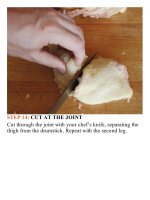The food lab better home cooking through science ( PDFDrive ) 180
Bạn đang xem bản rút gọn của tài liệu. Xem và tải ngay bản đầy đủ của tài liệu tại đây (133.89 KB, 2 trang )
ingredients lists, and they’re nearly identical: flour, butter,
bakingpowder,bakingsoda,andliquiddairy.Butoneends
up fluffy, tender, and relatively flat, and the other ends up
tall,flaky,andcrisp.Thedifferenceisallinthedetails.
First off, biscuits are a dough, not a batter, which means
thattheratioofflourtoliquidishighenoughthatitcanpull
everything together into a cohesive ball that’s soft but
doesn’t flow. Even more important is the way in which the
butter is incorporated. With pancakes, the butter is melted
and whisked into the batter, resulting in a sort of uniform
tenderness. For great flaky biscuits, on the other hand, the
butter is added cold and hard, and it’s addedbefore the
liquidis.Asyouworkthehardbutterintotheflour,youend
upwithamealymixcomprisedofsmallbitsofbuttercoated
inflour,someamountofaflour-and-butterpaste,andsome
completelydryflour.Nowaddyourliquidtothismix,and
what happens? Well, the dry flour immediately begins to
absorb water, forming gluten. Meanwhile, the flour
suspendedintheflour-butterpastedoesn’tabsorbanywater
at all, and, of course, you’ve still got your clumps of 100percentpurebutter.
Kneading the dough will cause the small pockets of
gluten to gradually link together into larger and larger
networks.All the while, butter-coated flour and pure butter
aresuspendedwithinthesenetworks.Asyourollthedough
out, everything gets flattened and elongated. The gluten
networks end up stretched into thin layers separated by
butterandbutter-coatedflour.
Finally,asthebiscuitsbake,acouplethingsoccur.First,
the butter melts, lubricating the spaces between the thin
glutensheets.Next,moisture—fromboththebutterandthe
liquid added to the dough—begins to vaporize, forming
bubbles that rapidly increase in volume and inflate the
interstitialspacesbetweentheglutenlayers,causingthemto
separate.Meanwhile,rememberthere’salsobakingpowder
and baking soda involved. This causes the parts of the
dough that are made up of flour and liquid to leaven and
inflate, adding tenderness and making the texture of the
biscuitslighter.
Folding
Oneofthekeystoultratenderbiscuitsisnotallthatdifferent
from making light pancakes: don’t overmix. You want to
knead the ingredients just until they come together.
Overmixing can lead to excess gluten formation, which
would make the biscuits tough.The other secret is to keep
everything cold. If your dough warms up too much, the
butter will begin to soften and become more evenly
distributed in the dough. You want the butter in distinct
pocketstohelpgivethebiscuitsavaried,fluffytexture.
Thereareacouplewaystohelpachievethesegoals.First
is to incorporate the butter using a food processor.A food
processor’s rapidly spinning blade will make short work of
thebutter,withlittletimeforittoheatupandbegintomelt.
Themethodbywhichyouincorporatethebuttermilkisalso
important. Some folks like to do it by hand, others in the
food processor. I find that the absolute best way is with a
flexible rubber spatula, gently folding the dough and
pressing it onto itself in a large bowl. Not only does the
foldingmotionminimizekneading(andthusgluten),italso









